When is the right time to get braces?
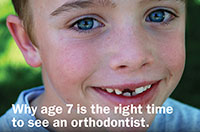 If you are considering braces for your child, the American Association of Orthodontists recommends children have their first orthodontic check up by age 7.
If you are considering braces for your child, the American Association of Orthodontists recommends children have their first orthodontic check up by age 7.
Why is this the recommendation?
The bite of a child is established when the first molars erupt. At that time, your orthodontist can evaluate the front to back and side to side relationship of the teeth. Unusual shifts and cross bites are also more easy to detect after this age. Other problems can be detected after the age of 7 as well. Crowding, finger or thumb habits, deep bites, open bites and some jaw discrepancies are much easier to treat at a young age.
For some, a timely evaluation will lead to significant treatment benefits. For others, the principal immediate benefit is a parent’s peace of mind.
What problems should I look for?
Cross bite
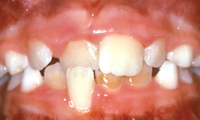 A cross bite occurs when the upper teeth align more towards the midline then the teeth in the lower arch. A cross bite can occur for many reasons such as improper tilting of teeth or an upper arch that is too narrow. Cross bites a usually treated with an expander or limited braces on some of the teeth.
A cross bite occurs when the upper teeth align more towards the midline then the teeth in the lower arch. A cross bite can occur for many reasons such as improper tilting of teeth or an upper arch that is too narrow. Cross bites a usually treated with an expander or limited braces on some of the teeth.
Open bite
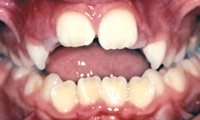 An open bite is a condition where a vertical space is present between the upper and lower teeth. Often open bites are present at the same time as an oral habit, such as thumb sucking. Common treatments include the use of a device to expand the upper arch with attachments that help stop the habit that is part of the problem.
An open bite is a condition where a vertical space is present between the upper and lower teeth. Often open bites are present at the same time as an oral habit, such as thumb sucking. Common treatments include the use of a device to expand the upper arch with attachments that help stop the habit that is part of the problem.
Crowding
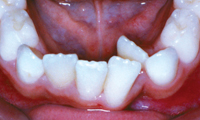 Crowding is a very common orthodontic condition that occurs when there is not enough space in the dental arches to accommodate the width necessary for each tooth that has erupted. Crowded teeth is a common esthetic concern. However, crowded teeth also makes it harder to keep your teeth clean and prevent cavities. A straighter smile is a healthy smile.
Crowding is a very common orthodontic condition that occurs when there is not enough space in the dental arches to accommodate the width necessary for each tooth that has erupted. Crowded teeth is a common esthetic concern. However, crowded teeth also makes it harder to keep your teeth clean and prevent cavities. A straighter smile is a healthy smile.
Under bite
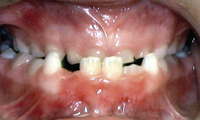 When a person has lower teeth that project further forward then the upper teeth and under bite is said to exist. Under bites are best to treat at a younger age. Treatment can involve the use of an expander and possibly an extra oral device to help gently pull the teeth and upper jaw forward in to the right spot.
When a person has lower teeth that project further forward then the upper teeth and under bite is said to exist. Under bites are best to treat at a younger age. Treatment can involve the use of an expander and possibly an extra oral device to help gently pull the teeth and upper jaw forward in to the right spot.
Thumb sucking
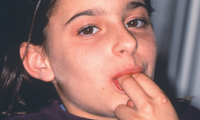 Thumb sucking is a behavior that can profoundly influence the alignment of developing teeth. Light, relatively continuous forces from the tongue, cheeks, and sometimes the thumb can commonly cause the upper front teeth to flare forward and a simultaneous open bite to occur.
Thumb sucking is a behavior that can profoundly influence the alignment of developing teeth. Light, relatively continuous forces from the tongue, cheeks, and sometimes the thumb can commonly cause the upper front teeth to flare forward and a simultaneous open bite to occur.
Flared front teeth
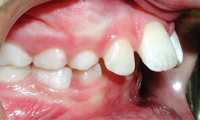 Front teeth that project too far forward are a common condition that patient’s seek orthodontic treatment for. Braces can improve both esthetics and function in these cases.
Front teeth that project too far forward are a common condition that patient’s seek orthodontic treatment for. Braces can improve both esthetics and function in these cases.
Photos and educational content courtesy of the American Association of Orthodontists.



